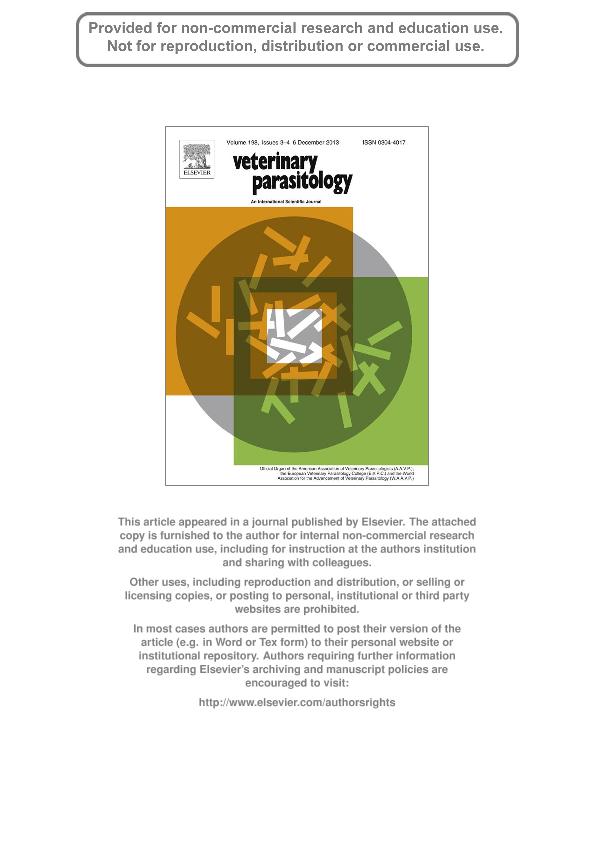Mostrar el registro sencillo del ítem
dc.contributor.author
Carletti, Tamara
dc.contributor.author
Martin, Mara

dc.contributor.author
Romero, Sandra

dc.contributor.author
Morrison, David A.
dc.contributor.author
Marcoppido, Gisela Ariana

dc.contributor.author
Jacobsen, Monica Ofelia

dc.contributor.author
Schnittger, Leonhard

dc.date.available
2017-11-15T17:26:15Z
dc.date.issued
2013-12
dc.identifier.citation
Carletti, Tamara; Martin, Mara; Romero, Sandra; Morrison, David A.; Marcoppido, Gisela Ariana; et al.; Molecular identification of Sarcocystis aucheniae as the macrocyst-forming parasite of llamas; Elsevier Science; Veterinary Parasitology; 198; 3-4; 12-2013; 396-400
dc.identifier.issn
0304-4017
dc.identifier.uri
http://hdl.handle.net/11336/28234
dc.description.abstract
The domestic South American camelids (SACs), llama (Lama glama) and alpaca (Lama paco), are frequently found to be infected with Sarcocystis parasites. Infections give rise in skeletal muscle to macroscopic cysts (1–5 mm long) that resemble rice seeds, each containing several million living bradyzoites. The finding of cysts prevents commercialization of SAC meat, an important source of income for rural families in the Andean flatlands. Thus, development of diagnostic methods to facilitate the control of these infections is highly desirable, and the first step to this end is the unequivocal species identification of the causative agent. Based on the cyst form and size, the infecting parasite has been described as Sarcocystis aucheniae; however, this traditional approach is not reliable as similar cysts may contain different species. To date, molecular identification has been done for a single isolate of S. aucheniae from an alpaca in Australia. In order to verify the identity of the species present in SACs of South America, the complete 18S rRNA gene was PCR-amplified and sequenced from macrocyst DNA obtained from three llamas of the Andean flatlands. A phylogenetic Bayesian analysis was carried out using the analyzed and available 18S rRNA sequences of Sarcocystis spp. In the constructed tree, all of the new 18S rRNA gene sequences segregated in a single clade together with the 18S rRNA gene sequence reported from an alpaca in Australia, demonstrating that the isolated parasite is S. aucheniae, and that this parasite indiscriminately infects both domestic SACs. This work represents the first molecular identification of the causative agent of SAC sarcocystiosis in South America, and can contribute to the development of control methods for this neglected parasitosis.
dc.format
application/pdf
dc.language.iso
eng
dc.publisher
Elsevier Science

dc.rights
info:eu-repo/semantics/openAccess
dc.rights.uri
https://creativecommons.org/licenses/by-nc-nd/2.5/ar/
dc.subject
Sarcocystiosis Aucheniae
dc.subject
Macroscopic Cyst
dc.subject
Phylogenetic Analysis
dc.subject
South American Camelids
dc.subject
Sarcocystiosis
dc.subject
Molecular Identification
dc.subject.classification
Ciencias Veterinarias

dc.subject.classification
Ciencias Veterinarias

dc.subject.classification
CIENCIAS AGRÍCOLAS

dc.title
Molecular identification of Sarcocystis aucheniae as the macrocyst-forming parasite of llamas
dc.type
info:eu-repo/semantics/article
dc.type
info:ar-repo/semantics/artículo
dc.type
info:eu-repo/semantics/publishedVersion
dc.date.updated
2017-11-15T13:49:00Z
dc.journal.volume
198
dc.journal.number
3-4
dc.journal.pagination
396-400
dc.journal.pais
Países Bajos

dc.journal.ciudad
Ámsterdam
dc.description.fil
Fil: Carletti, Tamara. Instituto Nacional de Tecnología Agropecuaria. Centro de Investigación en Ciencias Veterinarias y Agronómicas. Instituto de Patobiología; Argentina
dc.description.fil
Fil: Martin, Mara. Consejo Nacional de Investigaciones Científicas y Técnicas; Argentina. Instituto Nacional de Tecnología Agropecuaria. Centro de Investigación en Ciencias Veterinarias y Agronómicas. Instituto de Patobiología; Argentina
dc.description.fil
Fil: Romero, Sandra. Instituto Nacional de Tecnología Agropecuaria; Argentina
dc.description.fil
Fil: Morrison, David A.. Swedish University of Agricultural Sciences; Suecia
dc.description.fil
Fil: Marcoppido, Gisela Ariana. Instituto Nacional de Tecnología Agropecuaria. Centro de Investigación en Ciencias Veterinarias y Agronómicas. Instituto de Patobiología; Argentina. Consejo Nacional de Investigaciones Científicas y Técnicas; Argentina
dc.description.fil
Fil: Jacobsen, Monica Ofelia. Instituto Nacional de Tecnología Agropecuaria. Centro de Investigación en Ciencias Veterinarias y Agronómicas. Instituto de Patobiología; Argentina. Consejo Nacional de Investigaciones Científicas y Técnicas; Argentina
dc.description.fil
Fil: Schnittger, Leonhard. Instituto Nacional de Tecnología Agropecuaria. Centro de Investigación en Ciencias Veterinarias y Agronómicas. Instituto de Patobiología; Argentina. Consejo Nacional de Investigaciones Científicas y Técnicas; Argentina
dc.journal.title
Veterinary Parasitology

dc.relation.alternativeid
info:eu-repo/semantics/altIdentifier/doi/http://dx.doi.org/10.1016/j.vetpar.2013.09.007
Archivos asociados
